Elements of Law and Tort Cases
VerifiedAdded on 2020/01/16
|15
|5147
|145
AI Summary
This assignment delves into key concepts within legal studies. It examines elements essential to contracts and torts, utilizing provided scholarly works and online resources as sources. Students must analyze these elements and apply their knowledge through the lens of real-world cases outlined in the given materials. The focus is on understanding the practical application of legal principles.
Contribute Materials
Your contribution can guide someone’s learning journey. Share your
documents today.
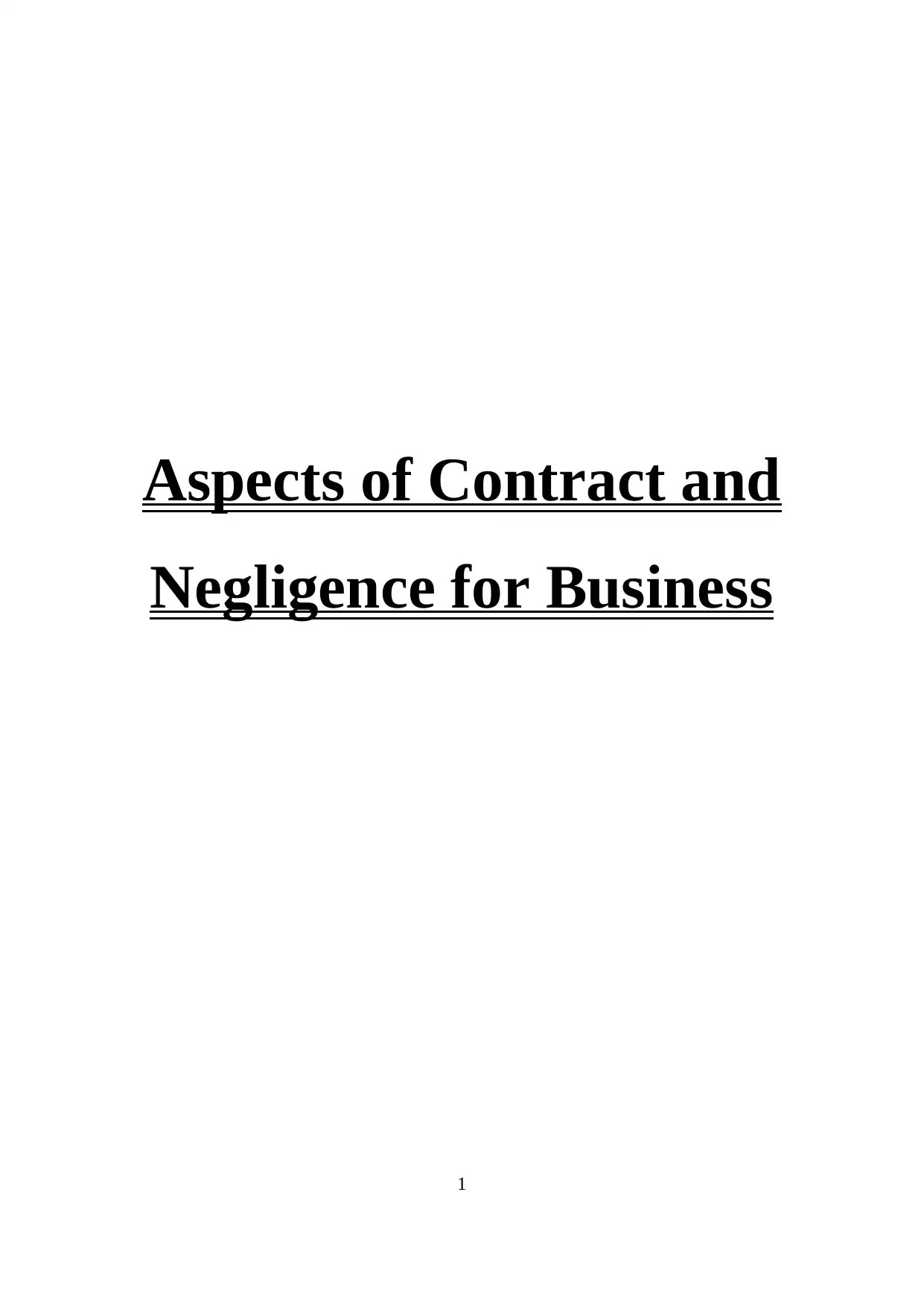
Aspects of Contract and
Negligence for Business
1
Negligence for Business
1
Secure Best Marks with AI Grader
Need help grading? Try our AI Grader for instant feedback on your assignments.
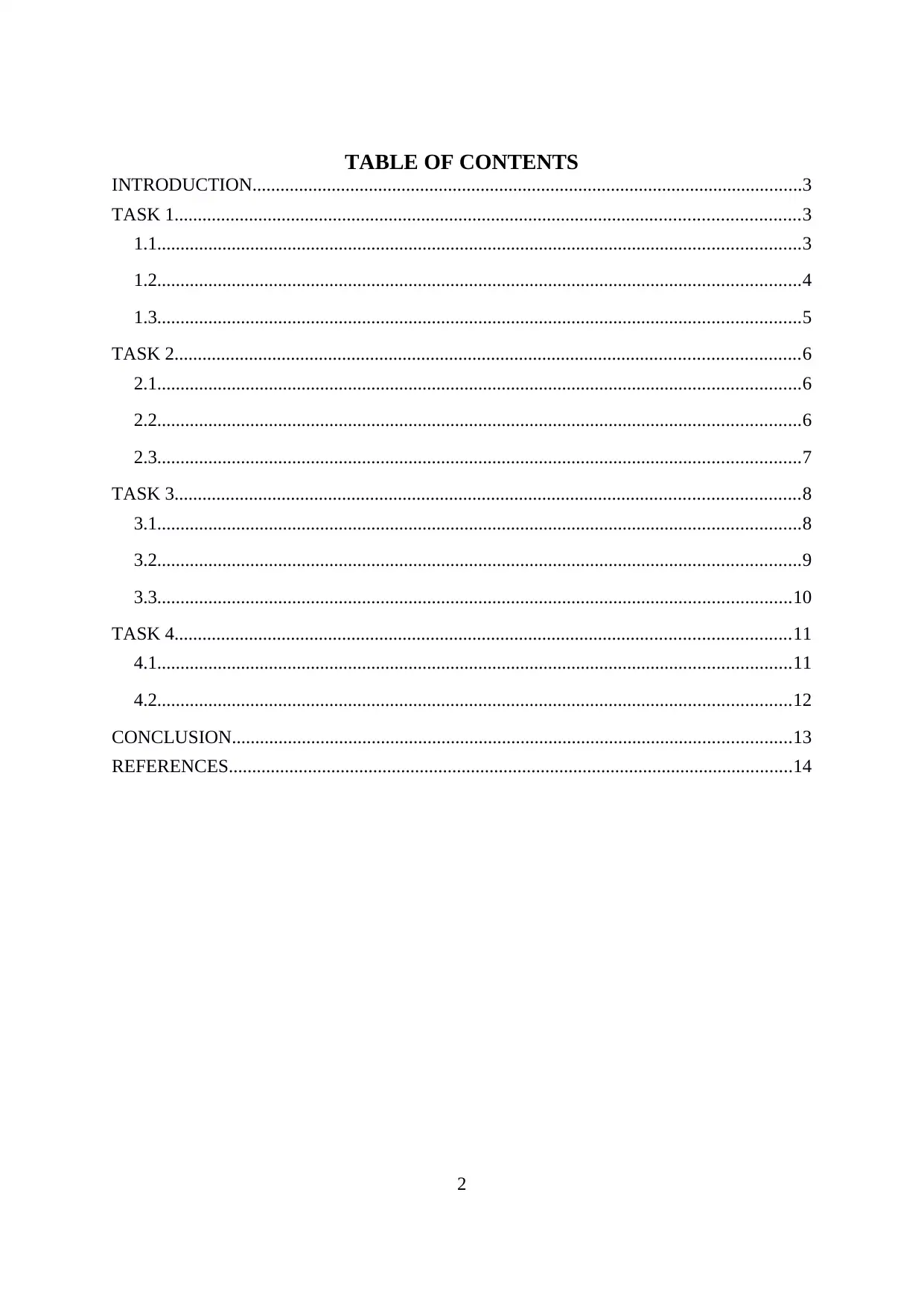
TABLE OF CONTENTS
INTRODUCTION......................................................................................................................3
TASK 1......................................................................................................................................3
1.1..........................................................................................................................................3
1.2..........................................................................................................................................4
1.3..........................................................................................................................................5
TASK 2......................................................................................................................................6
2.1..........................................................................................................................................6
2.2..........................................................................................................................................6
2.3..........................................................................................................................................7
TASK 3......................................................................................................................................8
3.1..........................................................................................................................................8
3.2..........................................................................................................................................9
3.3........................................................................................................................................10
TASK 4....................................................................................................................................11
4.1........................................................................................................................................11
4.2........................................................................................................................................12
CONCLUSION........................................................................................................................13
REFERENCES.........................................................................................................................14
2
INTRODUCTION......................................................................................................................3
TASK 1......................................................................................................................................3
1.1..........................................................................................................................................3
1.2..........................................................................................................................................4
1.3..........................................................................................................................................5
TASK 2......................................................................................................................................6
2.1..........................................................................................................................................6
2.2..........................................................................................................................................6
2.3..........................................................................................................................................7
TASK 3......................................................................................................................................8
3.1..........................................................................................................................................8
3.2..........................................................................................................................................9
3.3........................................................................................................................................10
TASK 4....................................................................................................................................11
4.1........................................................................................................................................11
4.2........................................................................................................................................12
CONCLUSION........................................................................................................................13
REFERENCES.........................................................................................................................14
2
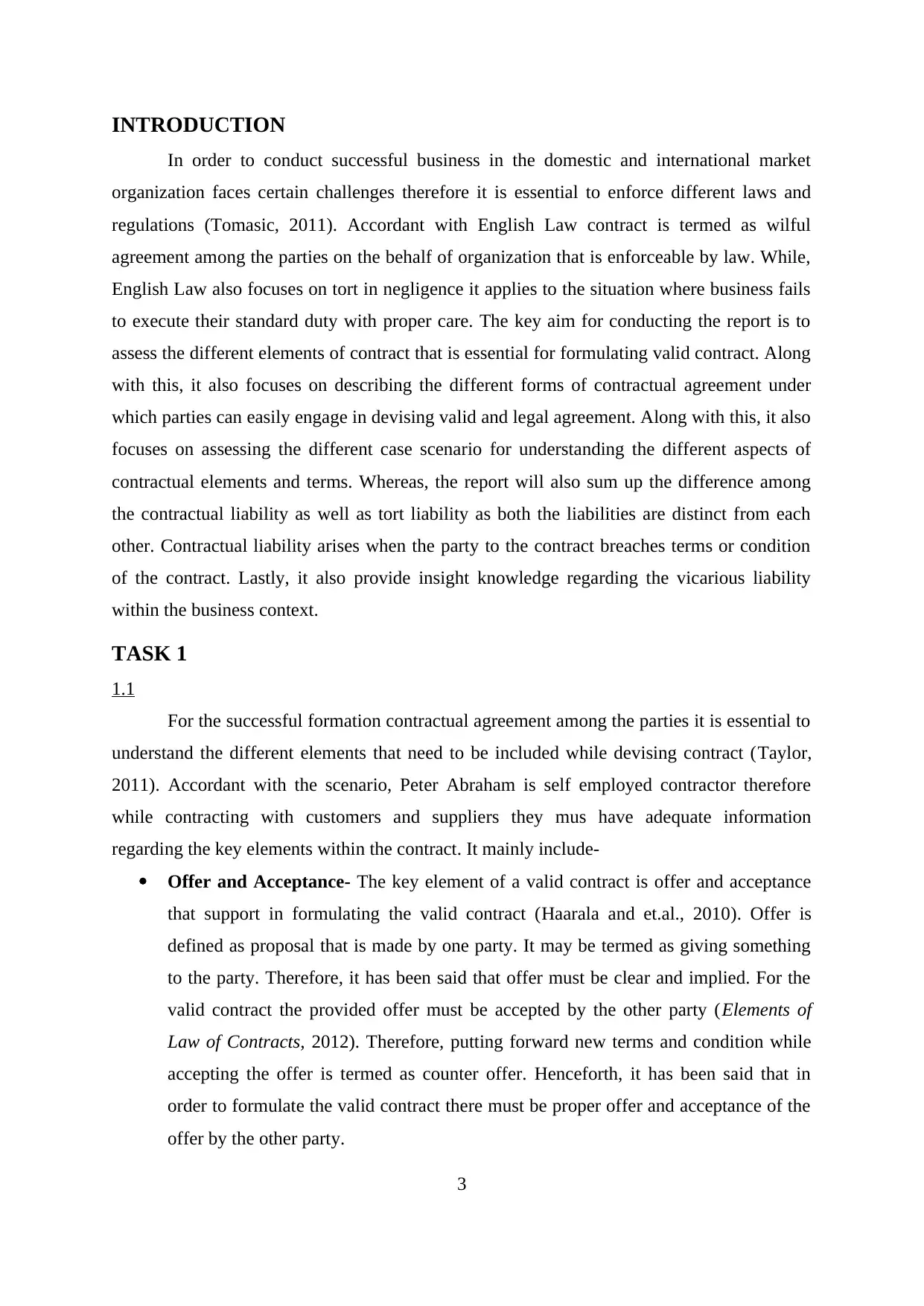
INTRODUCTION
In order to conduct successful business in the domestic and international market
organization faces certain challenges therefore it is essential to enforce different laws and
regulations (Tomasic, 2011). Accordant with English Law contract is termed as wilful
agreement among the parties on the behalf of organization that is enforceable by law. While,
English Law also focuses on tort in negligence it applies to the situation where business fails
to execute their standard duty with proper care. The key aim for conducting the report is to
assess the different elements of contract that is essential for formulating valid contract. Along
with this, it also focuses on describing the different forms of contractual agreement under
which parties can easily engage in devising valid and legal agreement. Along with this, it also
focuses on assessing the different case scenario for understanding the different aspects of
contractual elements and terms. Whereas, the report will also sum up the difference among
the contractual liability as well as tort liability as both the liabilities are distinct from each
other. Contractual liability arises when the party to the contract breaches terms or condition
of the contract. Lastly, it also provide insight knowledge regarding the vicarious liability
within the business context.
TASK 1
1.1
For the successful formation contractual agreement among the parties it is essential to
understand the different elements that need to be included while devising contract (Taylor,
2011). Accordant with the scenario, Peter Abraham is self employed contractor therefore
while contracting with customers and suppliers they mus have adequate information
regarding the key elements within the contract. It mainly include-
Offer and Acceptance- The key element of a valid contract is offer and acceptance
that support in formulating the valid contract (Haarala and et.al., 2010). Offer is
defined as proposal that is made by one party. It may be termed as giving something
to the party. Therefore, it has been said that offer must be clear and implied. For the
valid contract the provided offer must be accepted by the other party (Elements of
Law of Contracts, 2012). Therefore, putting forward new terms and condition while
accepting the offer is termed as counter offer. Henceforth, it has been said that in
order to formulate the valid contract there must be proper offer and acceptance of the
offer by the other party.
3
In order to conduct successful business in the domestic and international market
organization faces certain challenges therefore it is essential to enforce different laws and
regulations (Tomasic, 2011). Accordant with English Law contract is termed as wilful
agreement among the parties on the behalf of organization that is enforceable by law. While,
English Law also focuses on tort in negligence it applies to the situation where business fails
to execute their standard duty with proper care. The key aim for conducting the report is to
assess the different elements of contract that is essential for formulating valid contract. Along
with this, it also focuses on describing the different forms of contractual agreement under
which parties can easily engage in devising valid and legal agreement. Along with this, it also
focuses on assessing the different case scenario for understanding the different aspects of
contractual elements and terms. Whereas, the report will also sum up the difference among
the contractual liability as well as tort liability as both the liabilities are distinct from each
other. Contractual liability arises when the party to the contract breaches terms or condition
of the contract. Lastly, it also provide insight knowledge regarding the vicarious liability
within the business context.
TASK 1
1.1
For the successful formation contractual agreement among the parties it is essential to
understand the different elements that need to be included while devising contract (Taylor,
2011). Accordant with the scenario, Peter Abraham is self employed contractor therefore
while contracting with customers and suppliers they mus have adequate information
regarding the key elements within the contract. It mainly include-
Offer and Acceptance- The key element of a valid contract is offer and acceptance
that support in formulating the valid contract (Haarala and et.al., 2010). Offer is
defined as proposal that is made by one party. It may be termed as giving something
to the party. Therefore, it has been said that offer must be clear and implied. For the
valid contract the provided offer must be accepted by the other party (Elements of
Law of Contracts, 2012). Therefore, putting forward new terms and condition while
accepting the offer is termed as counter offer. Henceforth, it has been said that in
order to formulate the valid contract there must be proper offer and acceptance of the
offer by the other party.
3
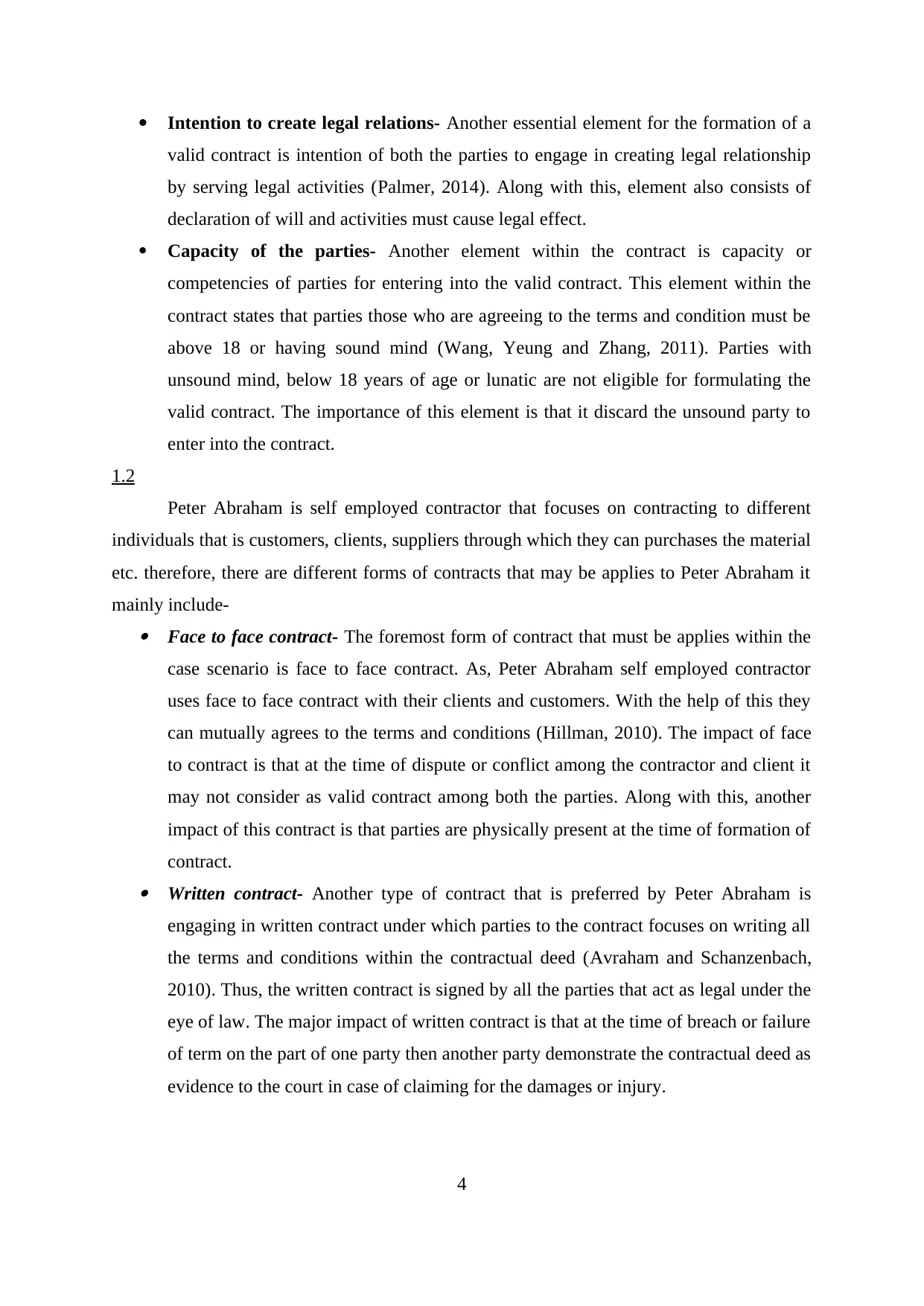
Intention to create legal relations- Another essential element for the formation of a
valid contract is intention of both the parties to engage in creating legal relationship
by serving legal activities (Palmer, 2014). Along with this, element also consists of
declaration of will and activities must cause legal effect.
Capacity of the parties- Another element within the contract is capacity or
competencies of parties for entering into the valid contract. This element within the
contract states that parties those who are agreeing to the terms and condition must be
above 18 or having sound mind (Wang, Yeung and Zhang, 2011). Parties with
unsound mind, below 18 years of age or lunatic are not eligible for formulating the
valid contract. The importance of this element is that it discard the unsound party to
enter into the contract.
1.2
Peter Abraham is self employed contractor that focuses on contracting to different
individuals that is customers, clients, suppliers through which they can purchases the material
etc. therefore, there are different forms of contracts that may be applies to Peter Abraham it
mainly include- Face to face contract- The foremost form of contract that must be applies within the
case scenario is face to face contract. As, Peter Abraham self employed contractor
uses face to face contract with their clients and customers. With the help of this they
can mutually agrees to the terms and conditions (Hillman, 2010). The impact of face
to contract is that at the time of dispute or conflict among the contractor and client it
may not consider as valid contract among both the parties. Along with this, another
impact of this contract is that parties are physically present at the time of formation of
contract. Written contract- Another type of contract that is preferred by Peter Abraham is
engaging in written contract under which parties to the contract focuses on writing all
the terms and conditions within the contractual deed (Avraham and Schanzenbach,
2010). Thus, the written contract is signed by all the parties that act as legal under the
eye of law. The major impact of written contract is that at the time of breach or failure
of term on the part of one party then another party demonstrate the contractual deed as
evidence to the court in case of claiming for the damages or injury.
4
valid contract is intention of both the parties to engage in creating legal relationship
by serving legal activities (Palmer, 2014). Along with this, element also consists of
declaration of will and activities must cause legal effect.
Capacity of the parties- Another element within the contract is capacity or
competencies of parties for entering into the valid contract. This element within the
contract states that parties those who are agreeing to the terms and condition must be
above 18 or having sound mind (Wang, Yeung and Zhang, 2011). Parties with
unsound mind, below 18 years of age or lunatic are not eligible for formulating the
valid contract. The importance of this element is that it discard the unsound party to
enter into the contract.
1.2
Peter Abraham is self employed contractor that focuses on contracting to different
individuals that is customers, clients, suppliers through which they can purchases the material
etc. therefore, there are different forms of contracts that may be applies to Peter Abraham it
mainly include- Face to face contract- The foremost form of contract that must be applies within the
case scenario is face to face contract. As, Peter Abraham self employed contractor
uses face to face contract with their clients and customers. With the help of this they
can mutually agrees to the terms and conditions (Hillman, 2010). The impact of face
to contract is that at the time of dispute or conflict among the contractor and client it
may not consider as valid contract among both the parties. Along with this, another
impact of this contract is that parties are physically present at the time of formation of
contract. Written contract- Another type of contract that is preferred by Peter Abraham is
engaging in written contract under which parties to the contract focuses on writing all
the terms and conditions within the contractual deed (Avraham and Schanzenbach,
2010). Thus, the written contract is signed by all the parties that act as legal under the
eye of law. The major impact of written contract is that at the time of breach or failure
of term on the part of one party then another party demonstrate the contractual deed as
evidence to the court in case of claiming for the damages or injury.
4
Secure Best Marks with AI Grader
Need help grading? Try our AI Grader for instant feedback on your assignments.
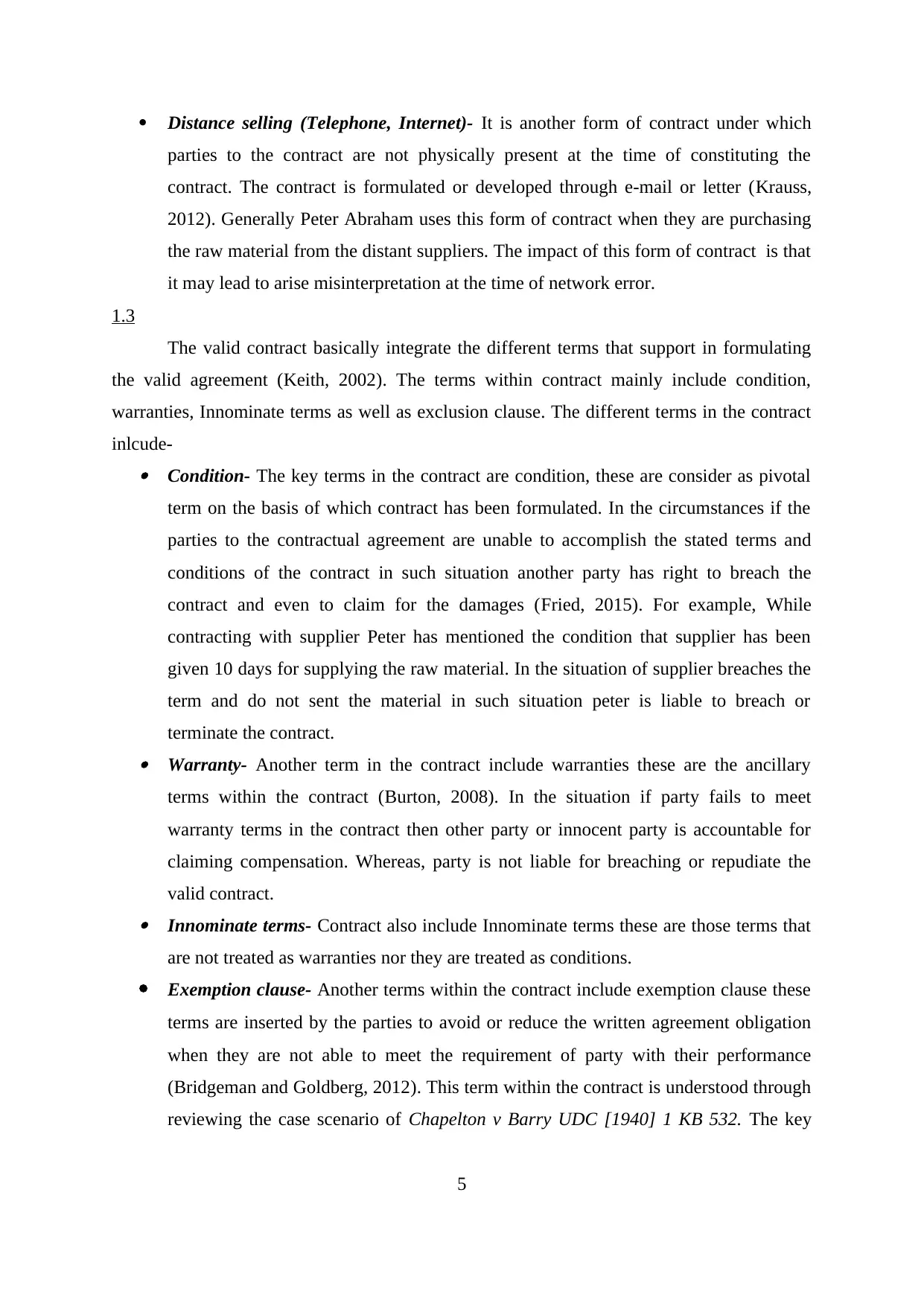
Distance selling (Telephone, Internet)- It is another form of contract under which
parties to the contract are not physically present at the time of constituting the
contract. The contract is formulated or developed through e-mail or letter (Krauss,
2012). Generally Peter Abraham uses this form of contract when they are purchasing
the raw material from the distant suppliers. The impact of this form of contract is that
it may lead to arise misinterpretation at the time of network error.
1.3
The valid contract basically integrate the different terms that support in formulating
the valid agreement (Keith, 2002). The terms within contract mainly include condition,
warranties, Innominate terms as well as exclusion clause. The different terms in the contract
inlcude- Condition- The key terms in the contract are condition, these are consider as pivotal
term on the basis of which contract has been formulated. In the circumstances if the
parties to the contractual agreement are unable to accomplish the stated terms and
conditions of the contract in such situation another party has right to breach the
contract and even to claim for the damages (Fried, 2015). For example, While
contracting with supplier Peter has mentioned the condition that supplier has been
given 10 days for supplying the raw material. In the situation of supplier breaches the
term and do not sent the material in such situation peter is liable to breach or
terminate the contract. Warranty- Another term in the contract include warranties these are the ancillary
terms within the contract (Burton, 2008). In the situation if party fails to meet
warranty terms in the contract then other party or innocent party is accountable for
claiming compensation. Whereas, party is not liable for breaching or repudiate the
valid contract. Innominate terms- Contract also include Innominate terms these are those terms that
are not treated as warranties nor they are treated as conditions.
Exemption clause- Another terms within the contract include exemption clause these
terms are inserted by the parties to avoid or reduce the written agreement obligation
when they are not able to meet the requirement of party with their performance
(Bridgeman and Goldberg, 2012). This term within the contract is understood through
reviewing the case scenario of Chapelton v Barry UDC [1940] 1 KB 532. The key
5
parties to the contract are not physically present at the time of constituting the
contract. The contract is formulated or developed through e-mail or letter (Krauss,
2012). Generally Peter Abraham uses this form of contract when they are purchasing
the raw material from the distant suppliers. The impact of this form of contract is that
it may lead to arise misinterpretation at the time of network error.
1.3
The valid contract basically integrate the different terms that support in formulating
the valid agreement (Keith, 2002). The terms within contract mainly include condition,
warranties, Innominate terms as well as exclusion clause. The different terms in the contract
inlcude- Condition- The key terms in the contract are condition, these are consider as pivotal
term on the basis of which contract has been formulated. In the circumstances if the
parties to the contractual agreement are unable to accomplish the stated terms and
conditions of the contract in such situation another party has right to breach the
contract and even to claim for the damages (Fried, 2015). For example, While
contracting with supplier Peter has mentioned the condition that supplier has been
given 10 days for supplying the raw material. In the situation of supplier breaches the
term and do not sent the material in such situation peter is liable to breach or
terminate the contract. Warranty- Another term in the contract include warranties these are the ancillary
terms within the contract (Burton, 2008). In the situation if party fails to meet
warranty terms in the contract then other party or innocent party is accountable for
claiming compensation. Whereas, party is not liable for breaching or repudiate the
valid contract. Innominate terms- Contract also include Innominate terms these are those terms that
are not treated as warranties nor they are treated as conditions.
Exemption clause- Another terms within the contract include exemption clause these
terms are inserted by the parties to avoid or reduce the written agreement obligation
when they are not able to meet the requirement of party with their performance
(Bridgeman and Goldberg, 2012). This term within the contract is understood through
reviewing the case scenario of Chapelton v Barry UDC [1940] 1 KB 532. The key
5
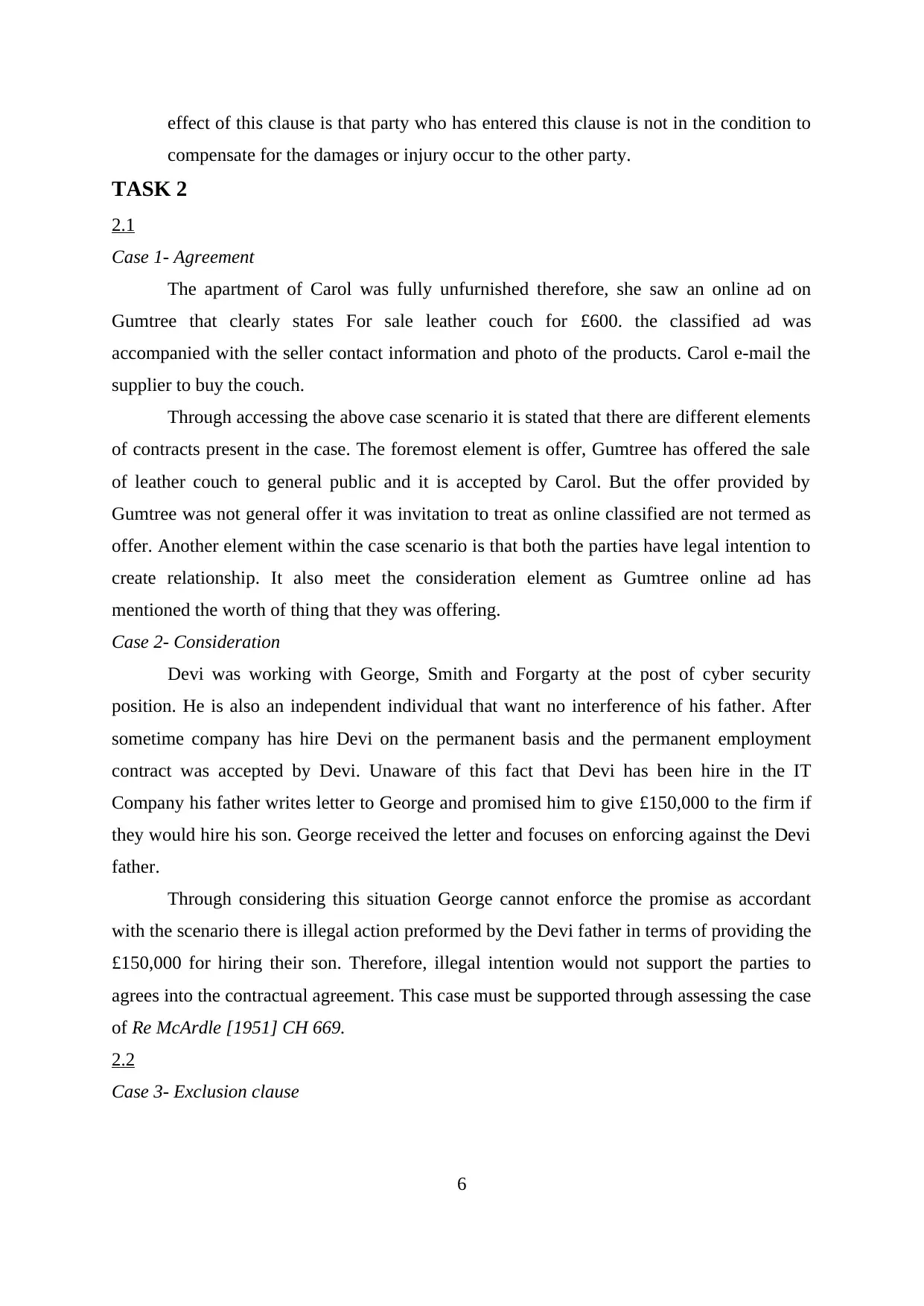
effect of this clause is that party who has entered this clause is not in the condition to
compensate for the damages or injury occur to the other party.
TASK 2
2.1
Case 1- Agreement
The apartment of Carol was fully unfurnished therefore, she saw an online ad on
Gumtree that clearly states For sale leather couch for £600. the classified ad was
accompanied with the seller contact information and photo of the products. Carol e-mail the
supplier to buy the couch.
Through accessing the above case scenario it is stated that there are different elements
of contracts present in the case. The foremost element is offer, Gumtree has offered the sale
of leather couch to general public and it is accepted by Carol. But the offer provided by
Gumtree was not general offer it was invitation to treat as online classified are not termed as
offer. Another element within the case scenario is that both the parties have legal intention to
create relationship. It also meet the consideration element as Gumtree online ad has
mentioned the worth of thing that they was offering.
Case 2- Consideration
Devi was working with George, Smith and Forgarty at the post of cyber security
position. He is also an independent individual that want no interference of his father. After
sometime company has hire Devi on the permanent basis and the permanent employment
contract was accepted by Devi. Unaware of this fact that Devi has been hire in the IT
Company his father writes letter to George and promised him to give £150,000 to the firm if
they would hire his son. George received the letter and focuses on enforcing against the Devi
father.
Through considering this situation George cannot enforce the promise as accordant
with the scenario there is illegal action preformed by the Devi father in terms of providing the
£150,000 for hiring their son. Therefore, illegal intention would not support the parties to
agrees into the contractual agreement. This case must be supported through assessing the case
of Re McArdle [1951] CH 669.
2.2
Case 3- Exclusion clause
6
compensate for the damages or injury occur to the other party.
TASK 2
2.1
Case 1- Agreement
The apartment of Carol was fully unfurnished therefore, she saw an online ad on
Gumtree that clearly states For sale leather couch for £600. the classified ad was
accompanied with the seller contact information and photo of the products. Carol e-mail the
supplier to buy the couch.
Through accessing the above case scenario it is stated that there are different elements
of contracts present in the case. The foremost element is offer, Gumtree has offered the sale
of leather couch to general public and it is accepted by Carol. But the offer provided by
Gumtree was not general offer it was invitation to treat as online classified are not termed as
offer. Another element within the case scenario is that both the parties have legal intention to
create relationship. It also meet the consideration element as Gumtree online ad has
mentioned the worth of thing that they was offering.
Case 2- Consideration
Devi was working with George, Smith and Forgarty at the post of cyber security
position. He is also an independent individual that want no interference of his father. After
sometime company has hire Devi on the permanent basis and the permanent employment
contract was accepted by Devi. Unaware of this fact that Devi has been hire in the IT
Company his father writes letter to George and promised him to give £150,000 to the firm if
they would hire his son. George received the letter and focuses on enforcing against the Devi
father.
Through considering this situation George cannot enforce the promise as accordant
with the scenario there is illegal action preformed by the Devi father in terms of providing the
£150,000 for hiring their son. Therefore, illegal intention would not support the parties to
agrees into the contractual agreement. This case must be supported through assessing the case
of Re McArdle [1951] CH 669.
2.2
Case 3- Exclusion clause
6
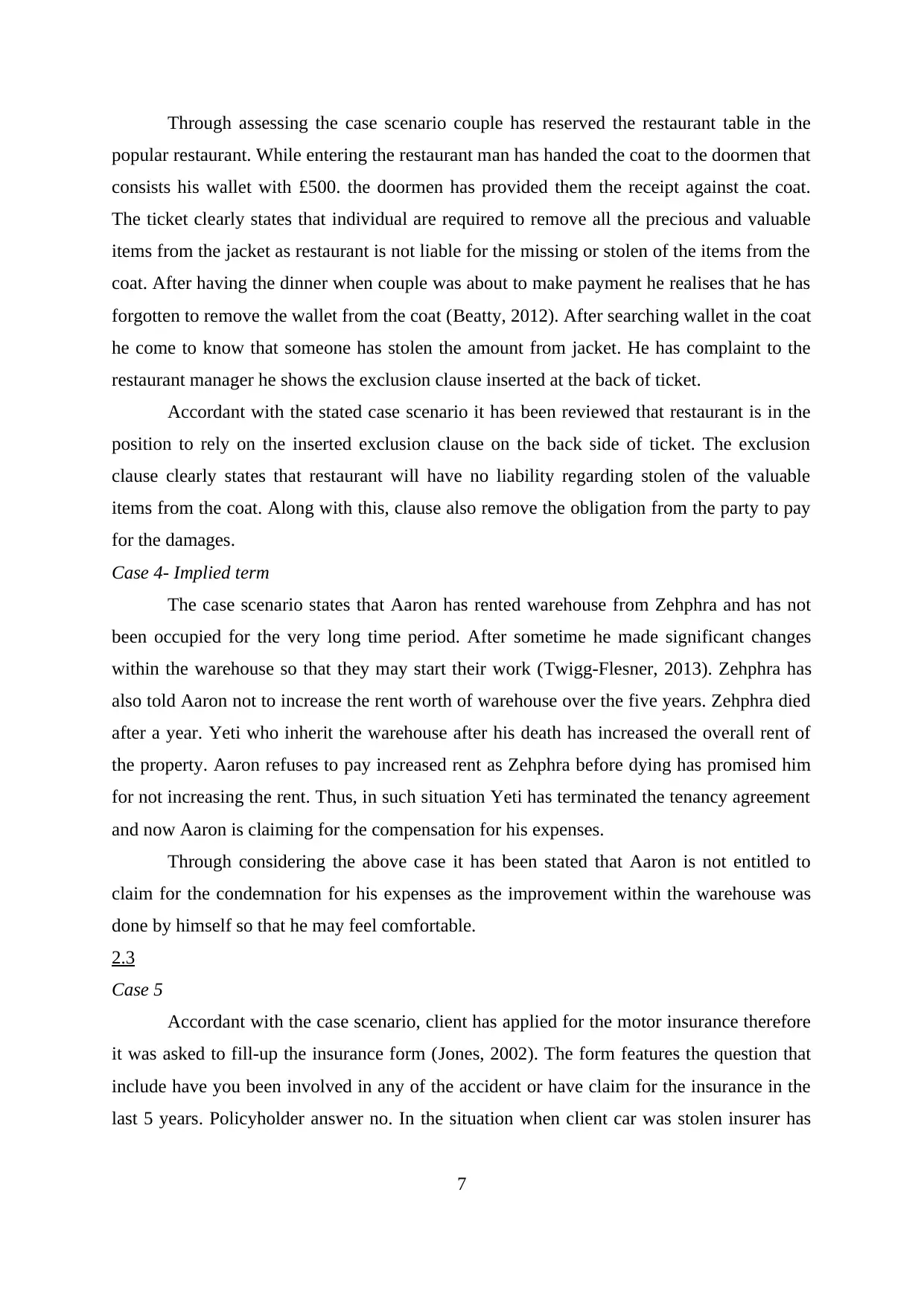
Through assessing the case scenario couple has reserved the restaurant table in the
popular restaurant. While entering the restaurant man has handed the coat to the doormen that
consists his wallet with £500. the doormen has provided them the receipt against the coat.
The ticket clearly states that individual are required to remove all the precious and valuable
items from the jacket as restaurant is not liable for the missing or stolen of the items from the
coat. After having the dinner when couple was about to make payment he realises that he has
forgotten to remove the wallet from the coat (Beatty, 2012). After searching wallet in the coat
he come to know that someone has stolen the amount from jacket. He has complaint to the
restaurant manager he shows the exclusion clause inserted at the back of ticket.
Accordant with the stated case scenario it has been reviewed that restaurant is in the
position to rely on the inserted exclusion clause on the back side of ticket. The exclusion
clause clearly states that restaurant will have no liability regarding stolen of the valuable
items from the coat. Along with this, clause also remove the obligation from the party to pay
for the damages.
Case 4- Implied term
The case scenario states that Aaron has rented warehouse from Zehphra and has not
been occupied for the very long time period. After sometime he made significant changes
within the warehouse so that they may start their work (Twigg-Flesner, 2013). Zehphra has
also told Aaron not to increase the rent worth of warehouse over the five years. Zehphra died
after a year. Yeti who inherit the warehouse after his death has increased the overall rent of
the property. Aaron refuses to pay increased rent as Zehphra before dying has promised him
for not increasing the rent. Thus, in such situation Yeti has terminated the tenancy agreement
and now Aaron is claiming for the compensation for his expenses.
Through considering the above case it has been stated that Aaron is not entitled to
claim for the condemnation for his expenses as the improvement within the warehouse was
done by himself so that he may feel comfortable.
2.3
Case 5
Accordant with the case scenario, client has applied for the motor insurance therefore
it was asked to fill-up the insurance form (Jones, 2002). The form features the question that
include have you been involved in any of the accident or have claim for the insurance in the
last 5 years. Policyholder answer no. In the situation when client car was stolen insurer has
7
popular restaurant. While entering the restaurant man has handed the coat to the doormen that
consists his wallet with £500. the doormen has provided them the receipt against the coat.
The ticket clearly states that individual are required to remove all the precious and valuable
items from the jacket as restaurant is not liable for the missing or stolen of the items from the
coat. After having the dinner when couple was about to make payment he realises that he has
forgotten to remove the wallet from the coat (Beatty, 2012). After searching wallet in the coat
he come to know that someone has stolen the amount from jacket. He has complaint to the
restaurant manager he shows the exclusion clause inserted at the back of ticket.
Accordant with the stated case scenario it has been reviewed that restaurant is in the
position to rely on the inserted exclusion clause on the back side of ticket. The exclusion
clause clearly states that restaurant will have no liability regarding stolen of the valuable
items from the coat. Along with this, clause also remove the obligation from the party to pay
for the damages.
Case 4- Implied term
The case scenario states that Aaron has rented warehouse from Zehphra and has not
been occupied for the very long time period. After sometime he made significant changes
within the warehouse so that they may start their work (Twigg-Flesner, 2013). Zehphra has
also told Aaron not to increase the rent worth of warehouse over the five years. Zehphra died
after a year. Yeti who inherit the warehouse after his death has increased the overall rent of
the property. Aaron refuses to pay increased rent as Zehphra before dying has promised him
for not increasing the rent. Thus, in such situation Yeti has terminated the tenancy agreement
and now Aaron is claiming for the compensation for his expenses.
Through considering the above case it has been stated that Aaron is not entitled to
claim for the condemnation for his expenses as the improvement within the warehouse was
done by himself so that he may feel comfortable.
2.3
Case 5
Accordant with the case scenario, client has applied for the motor insurance therefore
it was asked to fill-up the insurance form (Jones, 2002). The form features the question that
include have you been involved in any of the accident or have claim for the insurance in the
last 5 years. Policyholder answer no. In the situation when client car was stolen insurer has
7
Paraphrase This Document
Need a fresh take? Get an instant paraphrase of this document with our AI Paraphraser
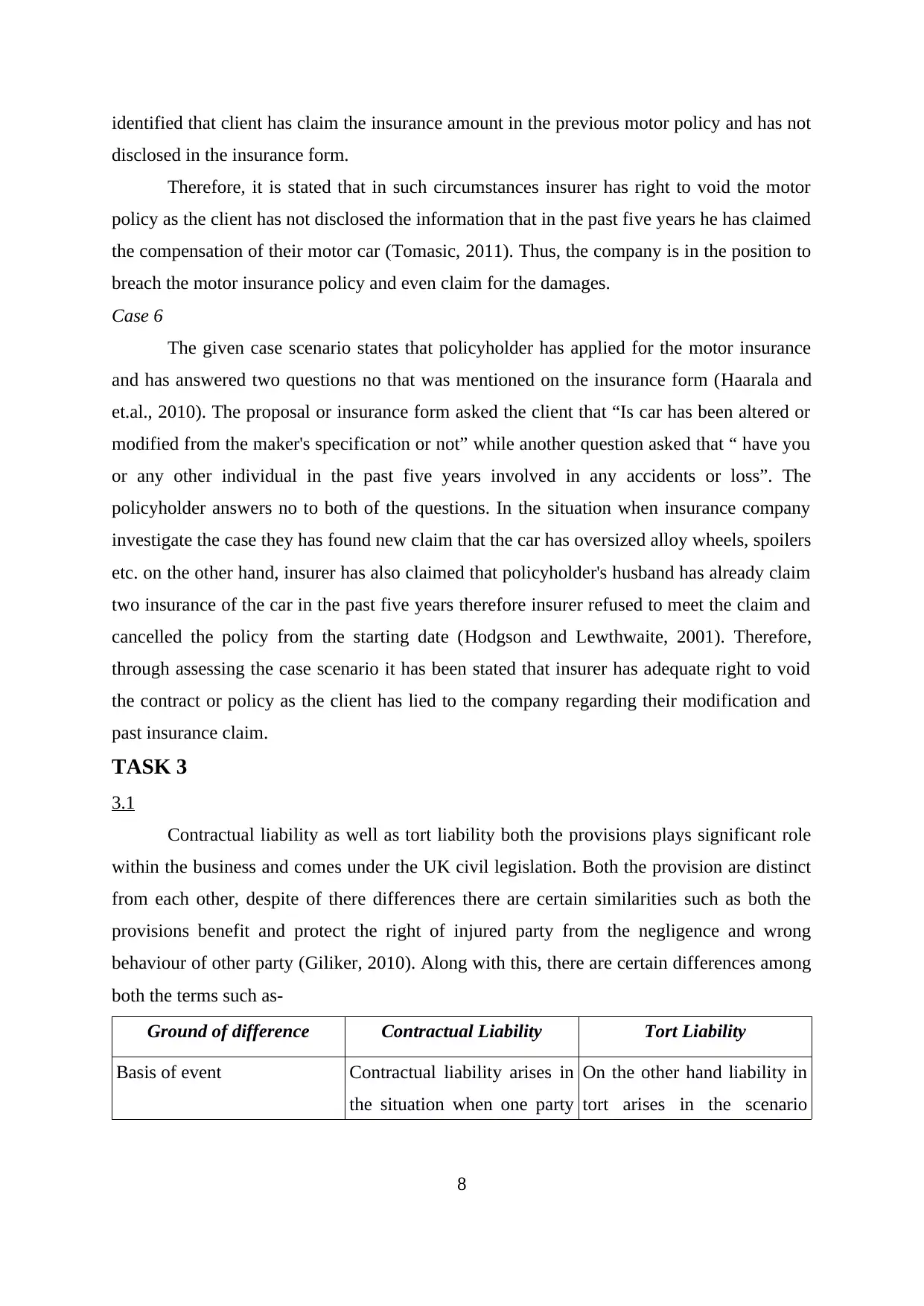
identified that client has claim the insurance amount in the previous motor policy and has not
disclosed in the insurance form.
Therefore, it is stated that in such circumstances insurer has right to void the motor
policy as the client has not disclosed the information that in the past five years he has claimed
the compensation of their motor car (Tomasic, 2011). Thus, the company is in the position to
breach the motor insurance policy and even claim for the damages.
Case 6
The given case scenario states that policyholder has applied for the motor insurance
and has answered two questions no that was mentioned on the insurance form (Haarala and
et.al., 2010). The proposal or insurance form asked the client that “Is car has been altered or
modified from the maker's specification or not” while another question asked that “ have you
or any other individual in the past five years involved in any accidents or loss”. The
policyholder answers no to both of the questions. In the situation when insurance company
investigate the case they has found new claim that the car has oversized alloy wheels, spoilers
etc. on the other hand, insurer has also claimed that policyholder's husband has already claim
two insurance of the car in the past five years therefore insurer refused to meet the claim and
cancelled the policy from the starting date (Hodgson and Lewthwaite, 2001). Therefore,
through assessing the case scenario it has been stated that insurer has adequate right to void
the contract or policy as the client has lied to the company regarding their modification and
past insurance claim.
TASK 3
3.1
Contractual liability as well as tort liability both the provisions plays significant role
within the business and comes under the UK civil legislation. Both the provision are distinct
from each other, despite of there differences there are certain similarities such as both the
provisions benefit and protect the right of injured party from the negligence and wrong
behaviour of other party (Giliker, 2010). Along with this, there are certain differences among
both the terms such as-
Ground of difference Contractual Liability Tort Liability
Basis of event Contractual liability arises in
the situation when one party
On the other hand liability in
tort arises in the scenario
8
disclosed in the insurance form.
Therefore, it is stated that in such circumstances insurer has right to void the motor
policy as the client has not disclosed the information that in the past five years he has claimed
the compensation of their motor car (Tomasic, 2011). Thus, the company is in the position to
breach the motor insurance policy and even claim for the damages.
Case 6
The given case scenario states that policyholder has applied for the motor insurance
and has answered two questions no that was mentioned on the insurance form (Haarala and
et.al., 2010). The proposal or insurance form asked the client that “Is car has been altered or
modified from the maker's specification or not” while another question asked that “ have you
or any other individual in the past five years involved in any accidents or loss”. The
policyholder answers no to both of the questions. In the situation when insurance company
investigate the case they has found new claim that the car has oversized alloy wheels, spoilers
etc. on the other hand, insurer has also claimed that policyholder's husband has already claim
two insurance of the car in the past five years therefore insurer refused to meet the claim and
cancelled the policy from the starting date (Hodgson and Lewthwaite, 2001). Therefore,
through assessing the case scenario it has been stated that insurer has adequate right to void
the contract or policy as the client has lied to the company regarding their modification and
past insurance claim.
TASK 3
3.1
Contractual liability as well as tort liability both the provisions plays significant role
within the business and comes under the UK civil legislation. Both the provision are distinct
from each other, despite of there differences there are certain similarities such as both the
provisions benefit and protect the right of injured party from the negligence and wrong
behaviour of other party (Giliker, 2010). Along with this, there are certain differences among
both the terms such as-
Ground of difference Contractual Liability Tort Liability
Basis of event Contractual liability arises in
the situation when one party
On the other hand liability in
tort arises in the scenario
8
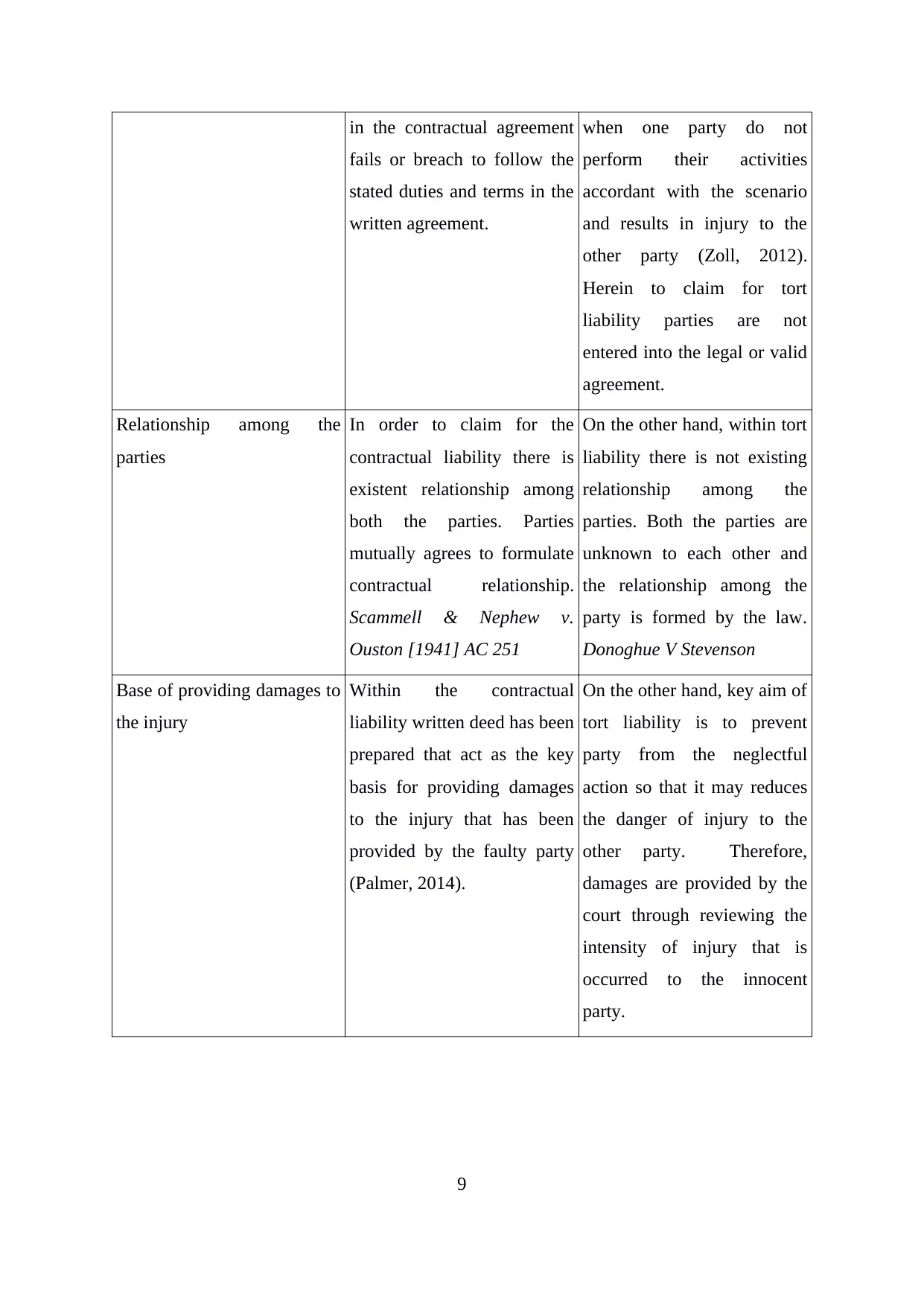
in the contractual agreement
fails or breach to follow the
stated duties and terms in the
written agreement.
when one party do not
perform their activities
accordant with the scenario
and results in injury to the
other party (Zoll, 2012).
Herein to claim for tort
liability parties are not
entered into the legal or valid
agreement.
Relationship among the
parties
In order to claim for the
contractual liability there is
existent relationship among
both the parties. Parties
mutually agrees to formulate
contractual relationship.
Scammell & Nephew v.
Ouston [1941] AC 251
On the other hand, within tort
liability there is not existing
relationship among the
parties. Both the parties are
unknown to each other and
the relationship among the
party is formed by the law.
Donoghue V Stevenson
Base of providing damages to
the injury
Within the contractual
liability written deed has been
prepared that act as the key
basis for providing damages
to the injury that has been
provided by the faulty party
(Palmer, 2014).
On the other hand, key aim of
tort liability is to prevent
party from the neglectful
action so that it may reduces
the danger of injury to the
other party. Therefore,
damages are provided by the
court through reviewing the
intensity of injury that is
occurred to the innocent
party.
9
fails or breach to follow the
stated duties and terms in the
written agreement.
when one party do not
perform their activities
accordant with the scenario
and results in injury to the
other party (Zoll, 2012).
Herein to claim for tort
liability parties are not
entered into the legal or valid
agreement.
Relationship among the
parties
In order to claim for the
contractual liability there is
existent relationship among
both the parties. Parties
mutually agrees to formulate
contractual relationship.
Scammell & Nephew v.
Ouston [1941] AC 251
On the other hand, within tort
liability there is not existing
relationship among the
parties. Both the parties are
unknown to each other and
the relationship among the
party is formed by the law.
Donoghue V Stevenson
Base of providing damages to
the injury
Within the contractual
liability written deed has been
prepared that act as the key
basis for providing damages
to the injury that has been
provided by the faulty party
(Palmer, 2014).
On the other hand, key aim of
tort liability is to prevent
party from the neglectful
action so that it may reduces
the danger of injury to the
other party. Therefore,
damages are provided by the
court through reviewing the
intensity of injury that is
occurred to the innocent
party.
9
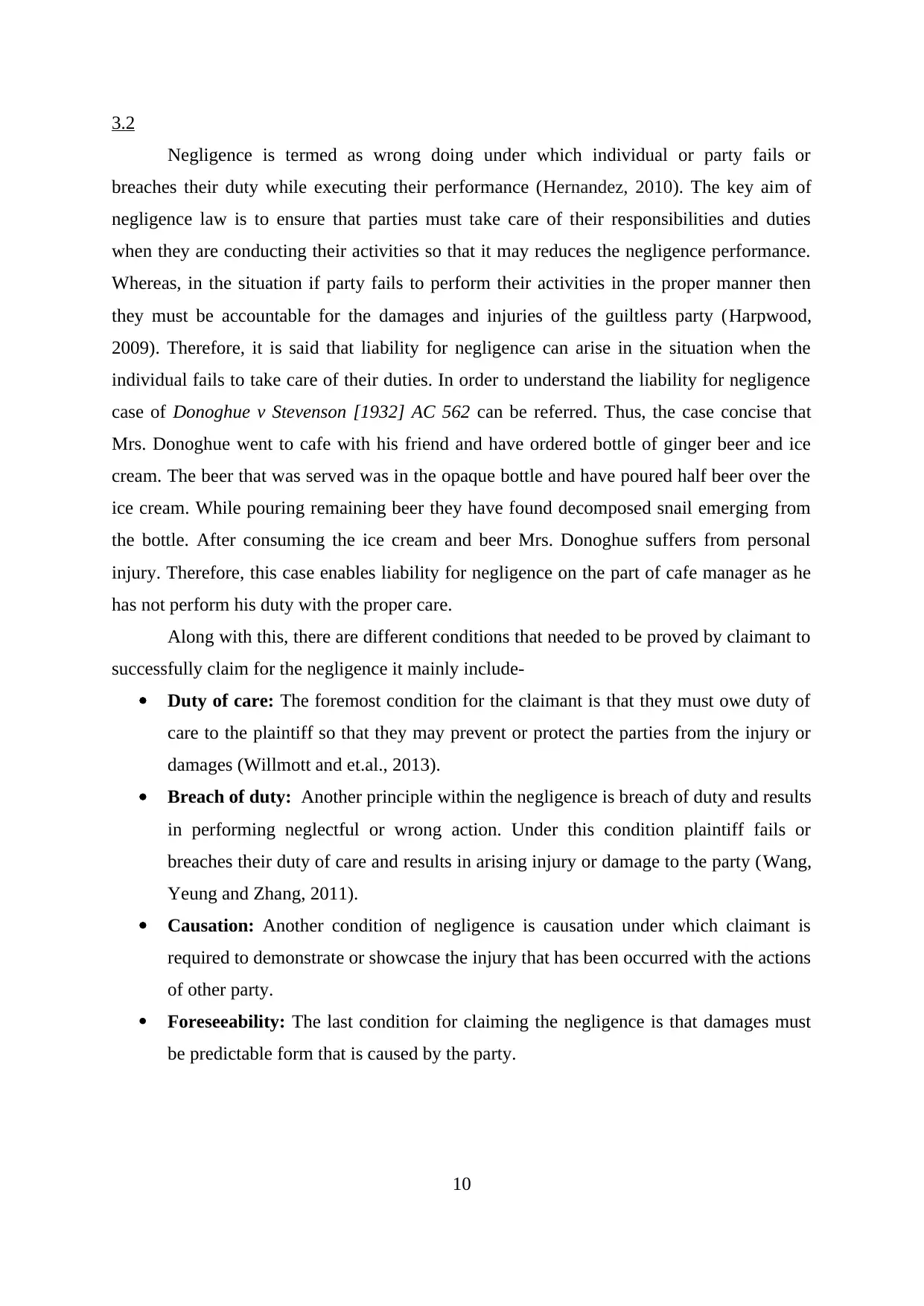
3.2
Negligence is termed as wrong doing under which individual or party fails or
breaches their duty while executing their performance (Hernandez, 2010). The key aim of
negligence law is to ensure that parties must take care of their responsibilities and duties
when they are conducting their activities so that it may reduces the negligence performance.
Whereas, in the situation if party fails to perform their activities in the proper manner then
they must be accountable for the damages and injuries of the guiltless party (Harpwood,
2009). Therefore, it is said that liability for negligence can arise in the situation when the
individual fails to take care of their duties. In order to understand the liability for negligence
case of Donoghue v Stevenson [1932] AC 562 can be referred. Thus, the case concise that
Mrs. Donoghue went to cafe with his friend and have ordered bottle of ginger beer and ice
cream. The beer that was served was in the opaque bottle and have poured half beer over the
ice cream. While pouring remaining beer they have found decomposed snail emerging from
the bottle. After consuming the ice cream and beer Mrs. Donoghue suffers from personal
injury. Therefore, this case enables liability for negligence on the part of cafe manager as he
has not perform his duty with the proper care.
Along with this, there are different conditions that needed to be proved by claimant to
successfully claim for the negligence it mainly include-
Duty of care: The foremost condition for the claimant is that they must owe duty of
care to the plaintiff so that they may prevent or protect the parties from the injury or
damages (Willmott and et.al., 2013).
Breach of duty: Another principle within the negligence is breach of duty and results
in performing neglectful or wrong action. Under this condition plaintiff fails or
breaches their duty of care and results in arising injury or damage to the party (Wang,
Yeung and Zhang, 2011).
Causation: Another condition of negligence is causation under which claimant is
required to demonstrate or showcase the injury that has been occurred with the actions
of other party.
Foreseeability: The last condition for claiming the negligence is that damages must
be predictable form that is caused by the party.
10
Negligence is termed as wrong doing under which individual or party fails or
breaches their duty while executing their performance (Hernandez, 2010). The key aim of
negligence law is to ensure that parties must take care of their responsibilities and duties
when they are conducting their activities so that it may reduces the negligence performance.
Whereas, in the situation if party fails to perform their activities in the proper manner then
they must be accountable for the damages and injuries of the guiltless party (Harpwood,
2009). Therefore, it is said that liability for negligence can arise in the situation when the
individual fails to take care of their duties. In order to understand the liability for negligence
case of Donoghue v Stevenson [1932] AC 562 can be referred. Thus, the case concise that
Mrs. Donoghue went to cafe with his friend and have ordered bottle of ginger beer and ice
cream. The beer that was served was in the opaque bottle and have poured half beer over the
ice cream. While pouring remaining beer they have found decomposed snail emerging from
the bottle. After consuming the ice cream and beer Mrs. Donoghue suffers from personal
injury. Therefore, this case enables liability for negligence on the part of cafe manager as he
has not perform his duty with the proper care.
Along with this, there are different conditions that needed to be proved by claimant to
successfully claim for the negligence it mainly include-
Duty of care: The foremost condition for the claimant is that they must owe duty of
care to the plaintiff so that they may prevent or protect the parties from the injury or
damages (Willmott and et.al., 2013).
Breach of duty: Another principle within the negligence is breach of duty and results
in performing neglectful or wrong action. Under this condition plaintiff fails or
breaches their duty of care and results in arising injury or damage to the party (Wang,
Yeung and Zhang, 2011).
Causation: Another condition of negligence is causation under which claimant is
required to demonstrate or showcase the injury that has been occurred with the actions
of other party.
Foreseeability: The last condition for claiming the negligence is that damages must
be predictable form that is caused by the party.
10
Secure Best Marks with AI Grader
Need help grading? Try our AI Grader for instant feedback on your assignments.
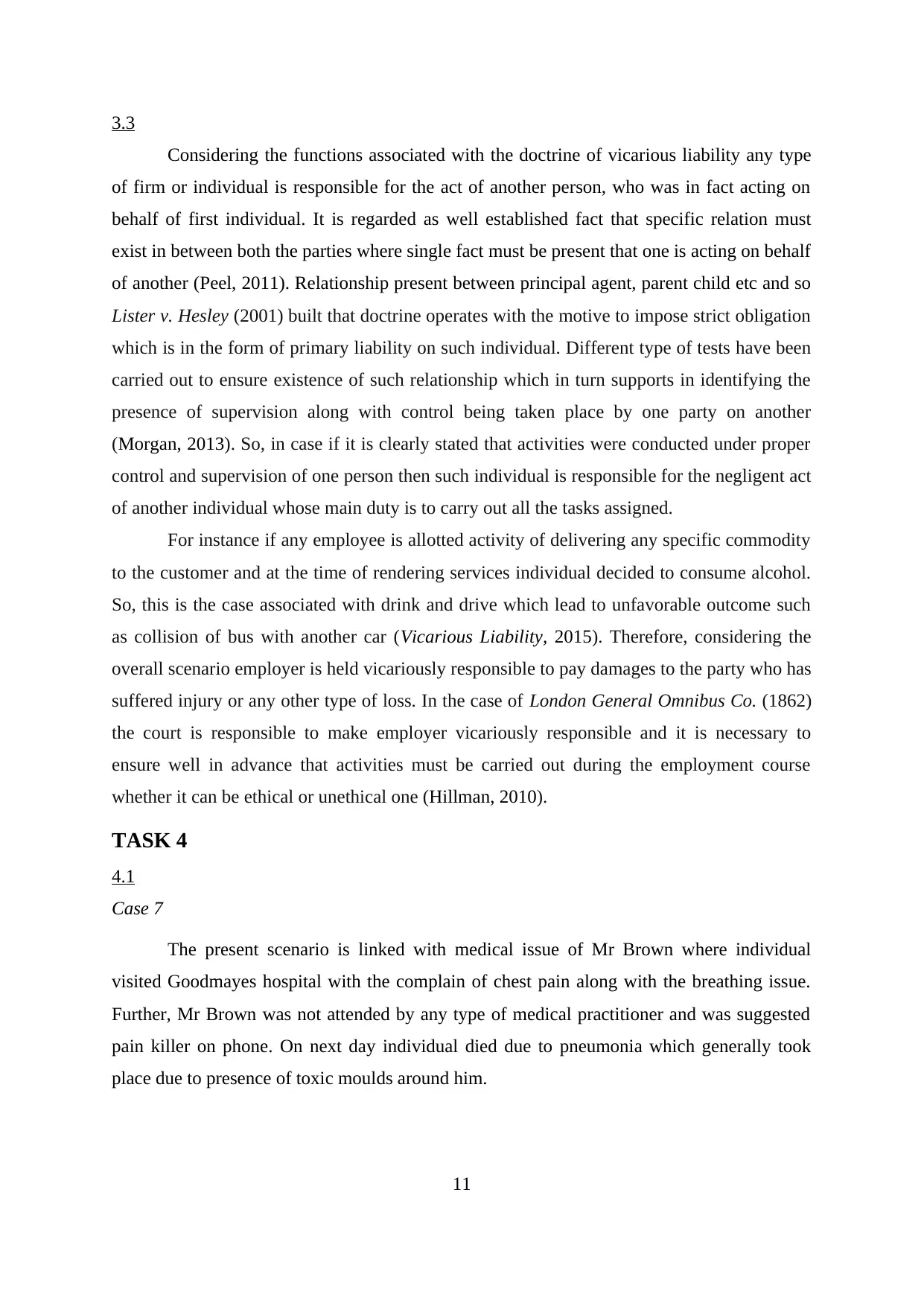
3.3
Considering the functions associated with the doctrine of vicarious liability any type
of firm or individual is responsible for the act of another person, who was in fact acting on
behalf of first individual. It is regarded as well established fact that specific relation must
exist in between both the parties where single fact must be present that one is acting on behalf
of another (Peel, 2011). Relationship present between principal agent, parent child etc and so
Lister v. Hesley (2001) built that doctrine operates with the motive to impose strict obligation
which is in the form of primary liability on such individual. Different type of tests have been
carried out to ensure existence of such relationship which in turn supports in identifying the
presence of supervision along with control being taken place by one party on another
(Morgan, 2013). So, in case if it is clearly stated that activities were conducted under proper
control and supervision of one person then such individual is responsible for the negligent act
of another individual whose main duty is to carry out all the tasks assigned.
For instance if any employee is allotted activity of delivering any specific commodity
to the customer and at the time of rendering services individual decided to consume alcohol.
So, this is the case associated with drink and drive which lead to unfavorable outcome such
as collision of bus with another car (Vicarious Liability, 2015). Therefore, considering the
overall scenario employer is held vicariously responsible to pay damages to the party who has
suffered injury or any other type of loss. In the case of London General Omnibus Co. (1862)
the court is responsible to make employer vicariously responsible and it is necessary to
ensure well in advance that activities must be carried out during the employment course
whether it can be ethical or unethical one (Hillman, 2010).
TASK 4
4.1
Case 7
The present scenario is linked with medical issue of Mr Brown where individual
visited Goodmayes hospital with the complain of chest pain along with the breathing issue.
Further, Mr Brown was not attended by any type of medical practitioner and was suggested
pain killer on phone. On next day individual died due to pneumonia which generally took
place due to presence of toxic moulds around him.
11
Considering the functions associated with the doctrine of vicarious liability any type
of firm or individual is responsible for the act of another person, who was in fact acting on
behalf of first individual. It is regarded as well established fact that specific relation must
exist in between both the parties where single fact must be present that one is acting on behalf
of another (Peel, 2011). Relationship present between principal agent, parent child etc and so
Lister v. Hesley (2001) built that doctrine operates with the motive to impose strict obligation
which is in the form of primary liability on such individual. Different type of tests have been
carried out to ensure existence of such relationship which in turn supports in identifying the
presence of supervision along with control being taken place by one party on another
(Morgan, 2013). So, in case if it is clearly stated that activities were conducted under proper
control and supervision of one person then such individual is responsible for the negligent act
of another individual whose main duty is to carry out all the tasks assigned.
For instance if any employee is allotted activity of delivering any specific commodity
to the customer and at the time of rendering services individual decided to consume alcohol.
So, this is the case associated with drink and drive which lead to unfavorable outcome such
as collision of bus with another car (Vicarious Liability, 2015). Therefore, considering the
overall scenario employer is held vicariously responsible to pay damages to the party who has
suffered injury or any other type of loss. In the case of London General Omnibus Co. (1862)
the court is responsible to make employer vicariously responsible and it is necessary to
ensure well in advance that activities must be carried out during the employment course
whether it can be ethical or unethical one (Hillman, 2010).
TASK 4
4.1
Case 7
The present scenario is linked with medical issue of Mr Brown where individual
visited Goodmayes hospital with the complain of chest pain along with the breathing issue.
Further, Mr Brown was not attended by any type of medical practitioner and was suggested
pain killer on phone. On next day individual died due to pneumonia which generally took
place due to presence of toxic moulds around him.
11
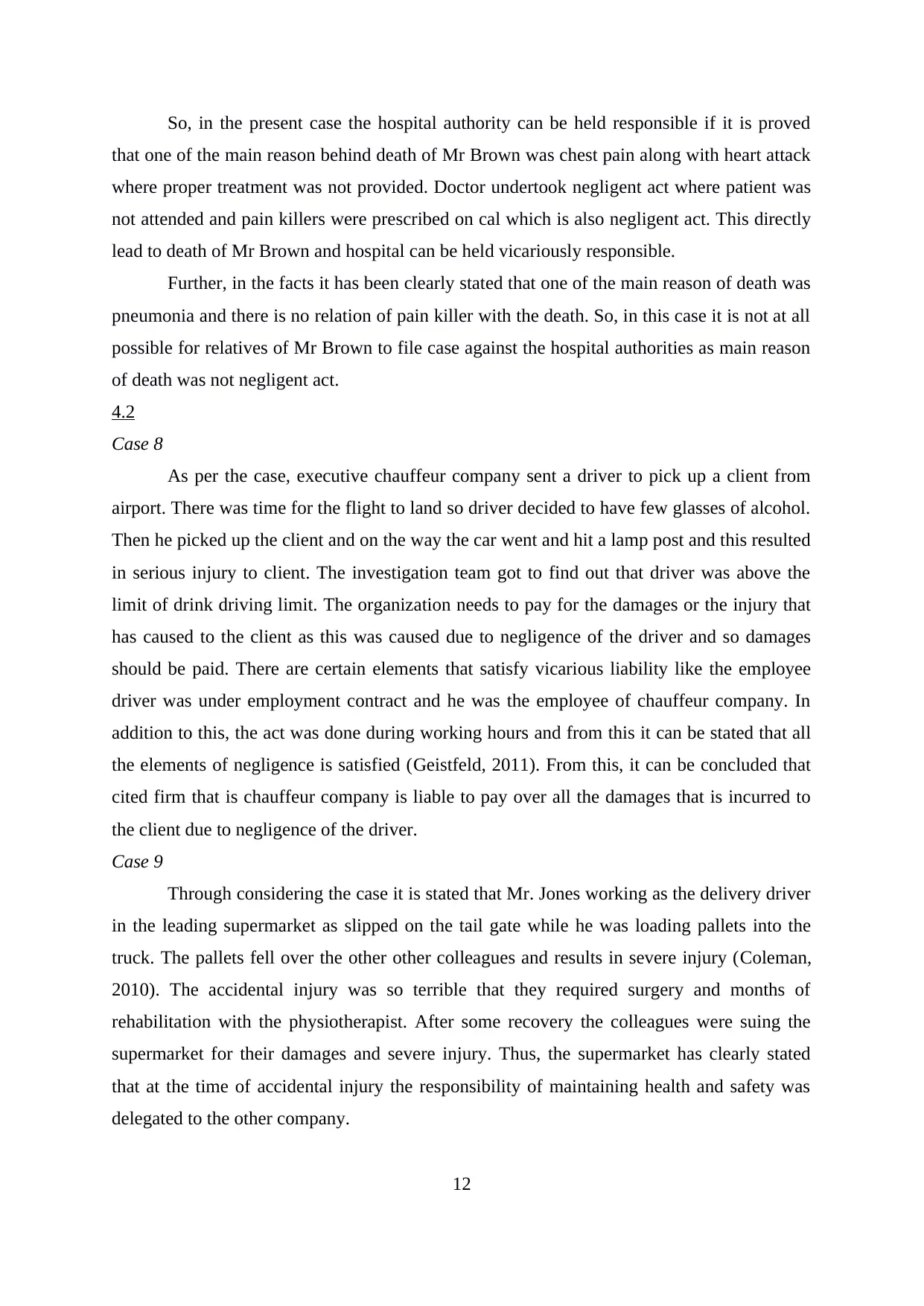
So, in the present case the hospital authority can be held responsible if it is proved
that one of the main reason behind death of Mr Brown was chest pain along with heart attack
where proper treatment was not provided. Doctor undertook negligent act where patient was
not attended and pain killers were prescribed on cal which is also negligent act. This directly
lead to death of Mr Brown and hospital can be held vicariously responsible.
Further, in the facts it has been clearly stated that one of the main reason of death was
pneumonia and there is no relation of pain killer with the death. So, in this case it is not at all
possible for relatives of Mr Brown to file case against the hospital authorities as main reason
of death was not negligent act.
4.2
Case 8
As per the case, executive chauffeur company sent a driver to pick up a client from
airport. There was time for the flight to land so driver decided to have few glasses of alcohol.
Then he picked up the client and on the way the car went and hit a lamp post and this resulted
in serious injury to client. The investigation team got to find out that driver was above the
limit of drink driving limit. The organization needs to pay for the damages or the injury that
has caused to the client as this was caused due to negligence of the driver and so damages
should be paid. There are certain elements that satisfy vicarious liability like the employee
driver was under employment contract and he was the employee of chauffeur company. In
addition to this, the act was done during working hours and from this it can be stated that all
the elements of negligence is satisfied (Geistfeld, 2011). From this, it can be concluded that
cited firm that is chauffeur company is liable to pay over all the damages that is incurred to
the client due to negligence of the driver.
Case 9
Through considering the case it is stated that Mr. Jones working as the delivery driver
in the leading supermarket as slipped on the tail gate while he was loading pallets into the
truck. The pallets fell over the other other colleagues and results in severe injury (Coleman,
2010). The accidental injury was so terrible that they required surgery and months of
rehabilitation with the physiotherapist. After some recovery the colleagues were suing the
supermarket for their damages and severe injury. Thus, the supermarket has clearly stated
that at the time of accidental injury the responsibility of maintaining health and safety was
delegated to the other company.
12
that one of the main reason behind death of Mr Brown was chest pain along with heart attack
where proper treatment was not provided. Doctor undertook negligent act where patient was
not attended and pain killers were prescribed on cal which is also negligent act. This directly
lead to death of Mr Brown and hospital can be held vicariously responsible.
Further, in the facts it has been clearly stated that one of the main reason of death was
pneumonia and there is no relation of pain killer with the death. So, in this case it is not at all
possible for relatives of Mr Brown to file case against the hospital authorities as main reason
of death was not negligent act.
4.2
Case 8
As per the case, executive chauffeur company sent a driver to pick up a client from
airport. There was time for the flight to land so driver decided to have few glasses of alcohol.
Then he picked up the client and on the way the car went and hit a lamp post and this resulted
in serious injury to client. The investigation team got to find out that driver was above the
limit of drink driving limit. The organization needs to pay for the damages or the injury that
has caused to the client as this was caused due to negligence of the driver and so damages
should be paid. There are certain elements that satisfy vicarious liability like the employee
driver was under employment contract and he was the employee of chauffeur company. In
addition to this, the act was done during working hours and from this it can be stated that all
the elements of negligence is satisfied (Geistfeld, 2011). From this, it can be concluded that
cited firm that is chauffeur company is liable to pay over all the damages that is incurred to
the client due to negligence of the driver.
Case 9
Through considering the case it is stated that Mr. Jones working as the delivery driver
in the leading supermarket as slipped on the tail gate while he was loading pallets into the
truck. The pallets fell over the other other colleagues and results in severe injury (Coleman,
2010). The accidental injury was so terrible that they required surgery and months of
rehabilitation with the physiotherapist. After some recovery the colleagues were suing the
supermarket for their damages and severe injury. Thus, the supermarket has clearly stated
that at the time of accidental injury the responsibility of maintaining health and safety was
delegated to the other company.
12
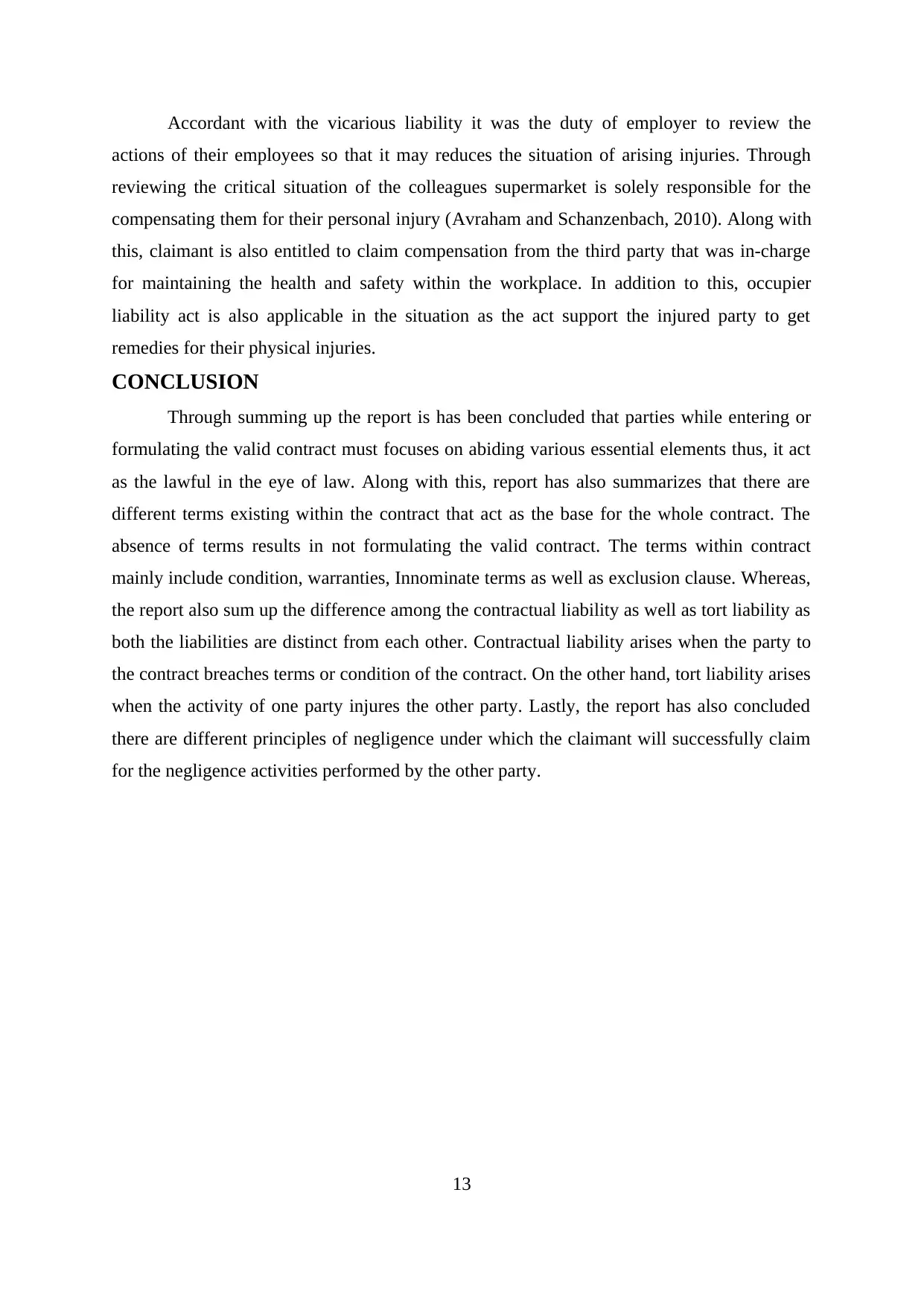
Accordant with the vicarious liability it was the duty of employer to review the
actions of their employees so that it may reduces the situation of arising injuries. Through
reviewing the critical situation of the colleagues supermarket is solely responsible for the
compensating them for their personal injury (Avraham and Schanzenbach, 2010). Along with
this, claimant is also entitled to claim compensation from the third party that was in-charge
for maintaining the health and safety within the workplace. In addition to this, occupier
liability act is also applicable in the situation as the act support the injured party to get
remedies for their physical injuries.
CONCLUSION
Through summing up the report is has been concluded that parties while entering or
formulating the valid contract must focuses on abiding various essential elements thus, it act
as the lawful in the eye of law. Along with this, report has also summarizes that there are
different terms existing within the contract that act as the base for the whole contract. The
absence of terms results in not formulating the valid contract. The terms within contract
mainly include condition, warranties, Innominate terms as well as exclusion clause. Whereas,
the report also sum up the difference among the contractual liability as well as tort liability as
both the liabilities are distinct from each other. Contractual liability arises when the party to
the contract breaches terms or condition of the contract. On the other hand, tort liability arises
when the activity of one party injures the other party. Lastly, the report has also concluded
there are different principles of negligence under which the claimant will successfully claim
for the negligence activities performed by the other party.
13
actions of their employees so that it may reduces the situation of arising injuries. Through
reviewing the critical situation of the colleagues supermarket is solely responsible for the
compensating them for their personal injury (Avraham and Schanzenbach, 2010). Along with
this, claimant is also entitled to claim compensation from the third party that was in-charge
for maintaining the health and safety within the workplace. In addition to this, occupier
liability act is also applicable in the situation as the act support the injured party to get
remedies for their physical injuries.
CONCLUSION
Through summing up the report is has been concluded that parties while entering or
formulating the valid contract must focuses on abiding various essential elements thus, it act
as the lawful in the eye of law. Along with this, report has also summarizes that there are
different terms existing within the contract that act as the base for the whole contract. The
absence of terms results in not formulating the valid contract. The terms within contract
mainly include condition, warranties, Innominate terms as well as exclusion clause. Whereas,
the report also sum up the difference among the contractual liability as well as tort liability as
both the liabilities are distinct from each other. Contractual liability arises when the party to
the contract breaches terms or condition of the contract. On the other hand, tort liability arises
when the activity of one party injures the other party. Lastly, the report has also concluded
there are different principles of negligence under which the claimant will successfully claim
for the negligence activities performed by the other party.
13
Paraphrase This Document
Need a fresh take? Get an instant paraphrase of this document with our AI Paraphraser
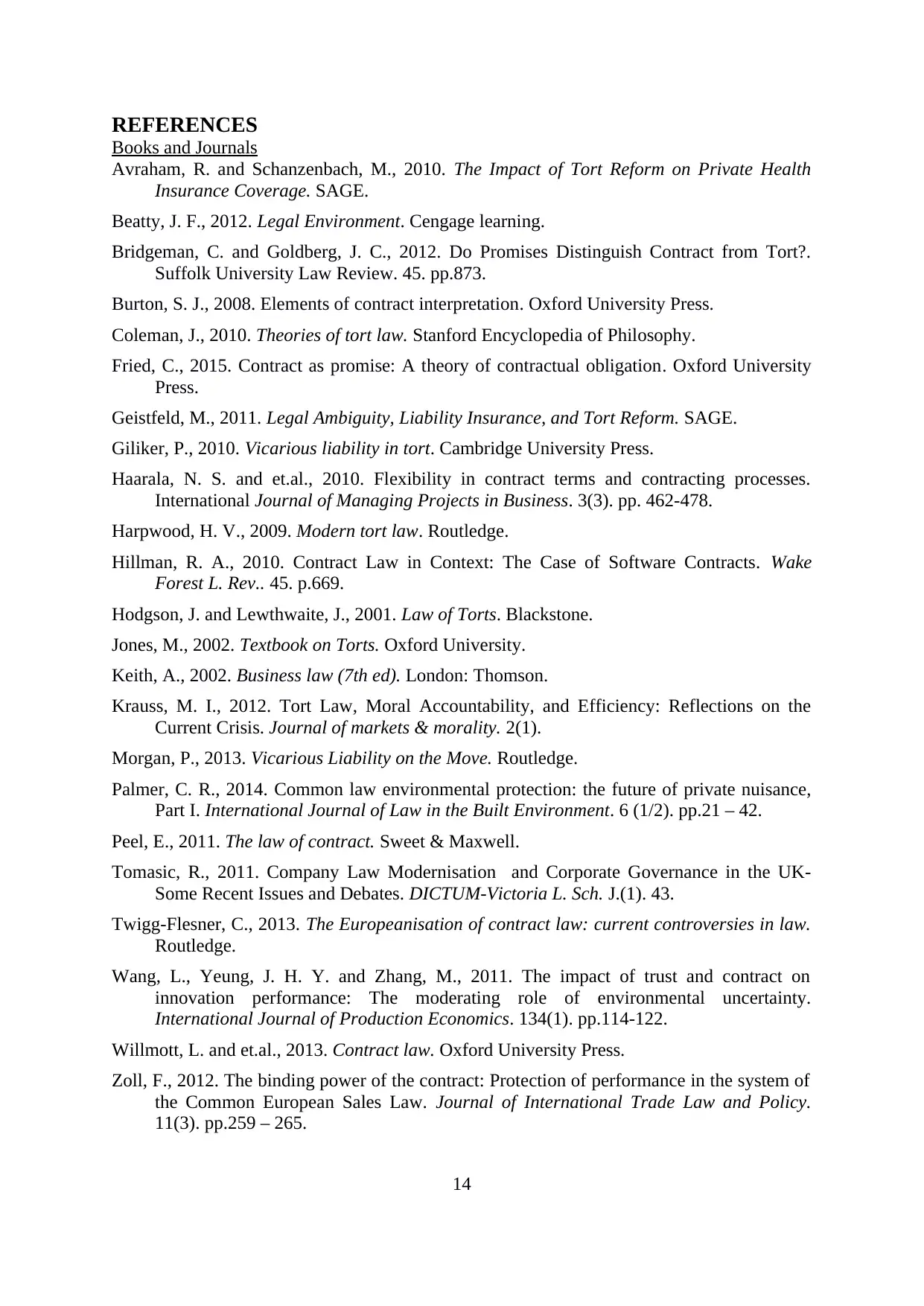
REFERENCES
Books and Journals
Avraham, R. and Schanzenbach, M., 2010. The Impact of Tort Reform on Private Health
Insurance Coverage. SAGE.
Beatty, J. F., 2012. Legal Environment. Cengage learning.
Bridgeman, C. and Goldberg, J. C., 2012. Do Promises Distinguish Contract from Tort?.
Suffolk University Law Review. 45. pp.873.
Burton, S. J., 2008. Elements of contract interpretation. Oxford University Press.
Coleman, J., 2010. Theories of tort law. Stanford Encyclopedia of Philosophy.
Fried, C., 2015. Contract as promise: A theory of contractual obligation. Oxford University
Press.
Geistfeld, M., 2011. Legal Ambiguity, Liability Insurance, and Tort Reform. SAGE.
Giliker, P., 2010. Vicarious liability in tort. Cambridge University Press.
Haarala, N. S. and et.al., 2010. Flexibility in contract terms and contracting processes.
International Journal of Managing Projects in Business. 3(3). pp. 462-478.
Harpwood, H. V., 2009. Modern tort law. Routledge.
Hillman, R. A., 2010. Contract Law in Context: The Case of Software Contracts. Wake
Forest L. Rev.. 45. p.669.
Hodgson, J. and Lewthwaite, J., 2001. Law of Torts. Blackstone.
Jones, M., 2002. Textbook on Torts. Oxford University.
Keith, A., 2002. Business law (7th ed). London: Thomson.
Krauss, M. I., 2012. Tort Law, Moral Accountability, and Efficiency: Reflections on the
Current Crisis. Journal of markets & morality. 2(1).
Morgan, P., 2013. Vicarious Liability on the Move. Routledge.
Palmer, C. R., 2014. Common law environmental protection: the future of private nuisance,
Part I. International Journal of Law in the Built Environment. 6 (1/2). pp.21 – 42.
Peel, E., 2011. The law of contract. Sweet & Maxwell.
Tomasic, R., 2011. Company Law Modernisation and Corporate Governance in the UK-
Some Recent Issues and Debates. DICTUM-Victoria L. Sch. J.(1). 43.
Twigg-Flesner, C., 2013. The Europeanisation of contract law: current controversies in law.
Routledge.
Wang, L., Yeung, J. H. Y. and Zhang, M., 2011. The impact of trust and contract on
innovation performance: The moderating role of environmental uncertainty.
International Journal of Production Economics. 134(1). pp.114-122.
Willmott, L. and et.al., 2013. Contract law. Oxford University Press.
Zoll, F., 2012. The binding power of the contract: Protection of performance in the system of
the Common European Sales Law. Journal of International Trade Law and Policy.
11(3). pp.259 – 265.
14
Books and Journals
Avraham, R. and Schanzenbach, M., 2010. The Impact of Tort Reform on Private Health
Insurance Coverage. SAGE.
Beatty, J. F., 2012. Legal Environment. Cengage learning.
Bridgeman, C. and Goldberg, J. C., 2012. Do Promises Distinguish Contract from Tort?.
Suffolk University Law Review. 45. pp.873.
Burton, S. J., 2008. Elements of contract interpretation. Oxford University Press.
Coleman, J., 2010. Theories of tort law. Stanford Encyclopedia of Philosophy.
Fried, C., 2015. Contract as promise: A theory of contractual obligation. Oxford University
Press.
Geistfeld, M., 2011. Legal Ambiguity, Liability Insurance, and Tort Reform. SAGE.
Giliker, P., 2010. Vicarious liability in tort. Cambridge University Press.
Haarala, N. S. and et.al., 2010. Flexibility in contract terms and contracting processes.
International Journal of Managing Projects in Business. 3(3). pp. 462-478.
Harpwood, H. V., 2009. Modern tort law. Routledge.
Hillman, R. A., 2010. Contract Law in Context: The Case of Software Contracts. Wake
Forest L. Rev.. 45. p.669.
Hodgson, J. and Lewthwaite, J., 2001. Law of Torts. Blackstone.
Jones, M., 2002. Textbook on Torts. Oxford University.
Keith, A., 2002. Business law (7th ed). London: Thomson.
Krauss, M. I., 2012. Tort Law, Moral Accountability, and Efficiency: Reflections on the
Current Crisis. Journal of markets & morality. 2(1).
Morgan, P., 2013. Vicarious Liability on the Move. Routledge.
Palmer, C. R., 2014. Common law environmental protection: the future of private nuisance,
Part I. International Journal of Law in the Built Environment. 6 (1/2). pp.21 – 42.
Peel, E., 2011. The law of contract. Sweet & Maxwell.
Tomasic, R., 2011. Company Law Modernisation and Corporate Governance in the UK-
Some Recent Issues and Debates. DICTUM-Victoria L. Sch. J.(1). 43.
Twigg-Flesner, C., 2013. The Europeanisation of contract law: current controversies in law.
Routledge.
Wang, L., Yeung, J. H. Y. and Zhang, M., 2011. The impact of trust and contract on
innovation performance: The moderating role of environmental uncertainty.
International Journal of Production Economics. 134(1). pp.114-122.
Willmott, L. and et.al., 2013. Contract law. Oxford University Press.
Zoll, F., 2012. The binding power of the contract: Protection of performance in the system of
the Common European Sales Law. Journal of International Trade Law and Policy.
11(3). pp.259 – 265.
14
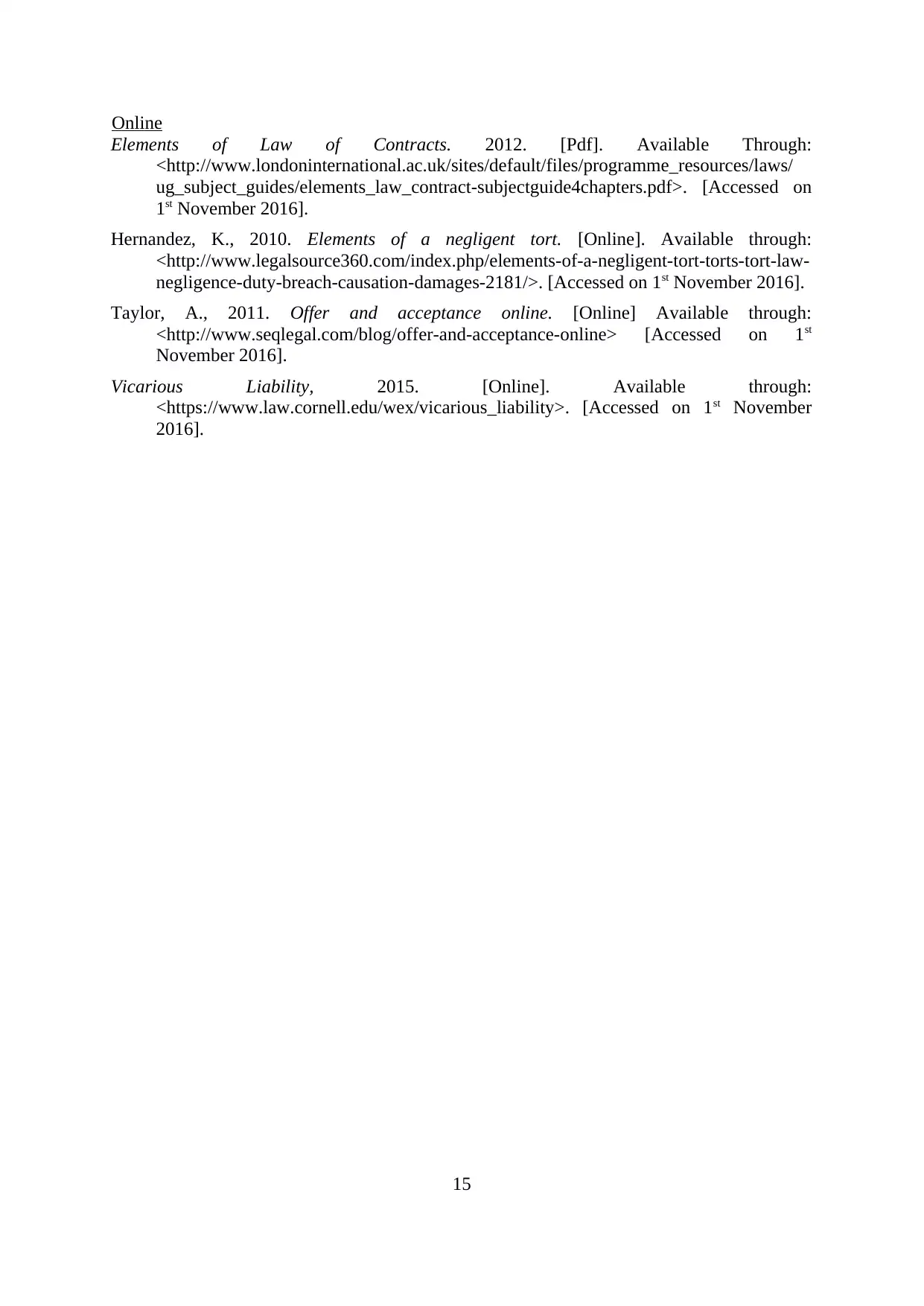
Online
Elements of Law of Contracts. 2012. [Pdf]. Available Through:
<http://www.londoninternational.ac.uk/sites/default/files/programme_resources/laws/
ug_subject_guides/elements_law_contract-subjectguide4chapters.pdf>. [Accessed on
1st November 2016].
Hernandez, K., 2010. Elements of a negligent tort. [Online]. Available through:
<http://www.legalsource360.com/index.php/elements-of-a-negligent-tort-torts-tort-law-
negligence-duty-breach-causation-damages-2181/>. [Accessed on 1st November 2016].
Taylor, A., 2011. Offer and acceptance online. [Online] Available through:
<http://www.seqlegal.com/blog/offer-and-acceptance-online> [Accessed on 1st
November 2016].
Vicarious Liability, 2015. [Online]. Available through:
<https://www.law.cornell.edu/wex/vicarious_liability>. [Accessed on 1st November
2016].
15
Elements of Law of Contracts. 2012. [Pdf]. Available Through:
<http://www.londoninternational.ac.uk/sites/default/files/programme_resources/laws/
ug_subject_guides/elements_law_contract-subjectguide4chapters.pdf>. [Accessed on
1st November 2016].
Hernandez, K., 2010. Elements of a negligent tort. [Online]. Available through:
<http://www.legalsource360.com/index.php/elements-of-a-negligent-tort-torts-tort-law-
negligence-duty-breach-causation-damages-2181/>. [Accessed on 1st November 2016].
Taylor, A., 2011. Offer and acceptance online. [Online] Available through:
<http://www.seqlegal.com/blog/offer-and-acceptance-online> [Accessed on 1st
November 2016].
Vicarious Liability, 2015. [Online]. Available through:
<https://www.law.cornell.edu/wex/vicarious_liability>. [Accessed on 1st November
2016].
15
1 out of 15
Related Documents
Your All-in-One AI-Powered Toolkit for Academic Success.
+13062052269
info@desklib.com
Available 24*7 on WhatsApp / Email
![[object Object]](/_next/static/media/star-bottom.7253800d.svg)
Unlock your academic potential
© 2024 | Zucol Services PVT LTD | All rights reserved.





